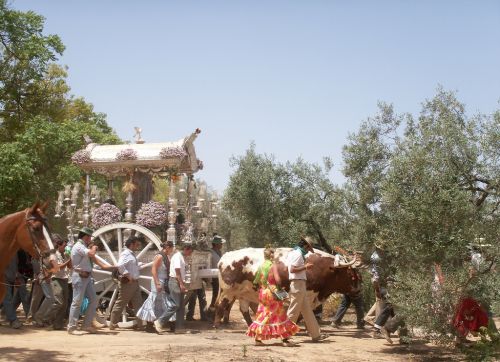El Rocío
El Rocío is probably the most popular Spanish pilgrimage. Almost 1 million people participate in it each year. It is held over the weekend before Pentecost Monday, or if you find it easier, on the 7th weekend after Easter. In 2013 it will be on the 19th and 20th of May.
 Virgen Del Rocío
Virgen Del Rocío
The pilgrimage is organized in the town of El Rocío, Andalucia. Pilgrims or rocieros participating in it worship the 13th century statue of the Virgen Del Rocío (Virgin of the Dew). Many pilgrims are organized in Catholic brotherhoods. In the town of El Rocío there are houses, stables and chapels owned by almost 100 brotherhoods.
 El Rocío
El Rocío
The arrival to the place of pilgrimage is an amazing by itself. Many people traditionally travel in a small ox-drawn covered wagon called carreta. Some wagons are pulled by tractors. Wagons are followed by numerous riders. People wear traditional Andalucian hats and clothes. There is lot of Flamenco music and dance. Songs about pilgrimage known as rocieras are sang. Each brotherhood has a special wagon with its own Virgin statue set on a float (simpecado). Pilgrims usually travel on 3 main routes starting from Triana, Sanlucar de Barrameda and Huelva.
On the Pentecost Monday statue of the Virgen Del Rocío is taken out of the church by the members of Almonte brotherhood. After that the statue is transferred from one brotherhood to another and that way travels from chapel to chapel. Among pilgrims Virgen Del Rocío is also known as La Paloma Blanca (the White Dove). They try to touch the glass float on which the statue is carried.
El Rocío is not only religion. It also includes parties and various competitions like for example horse races.